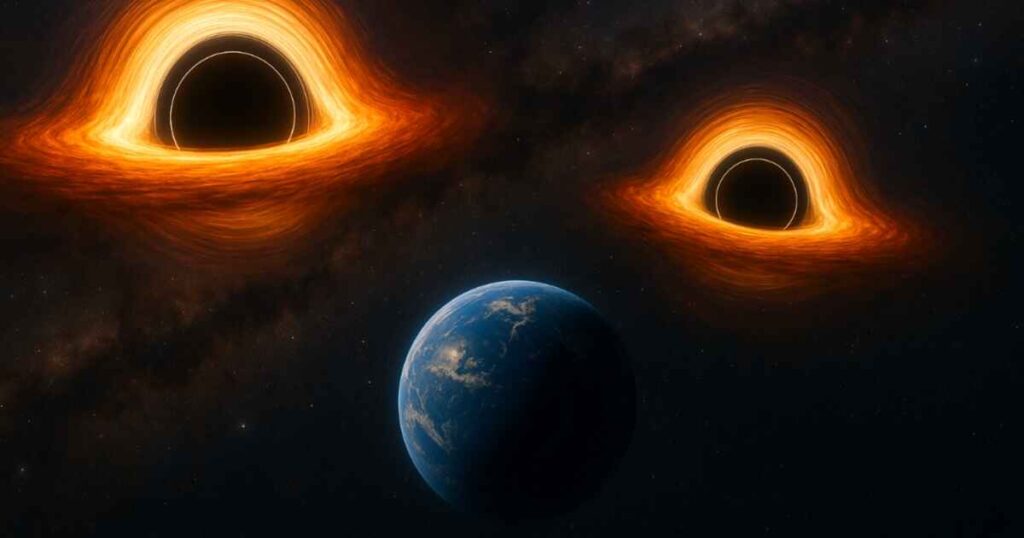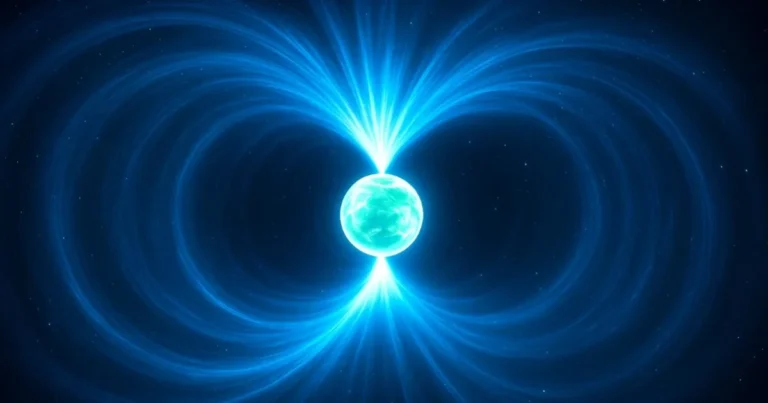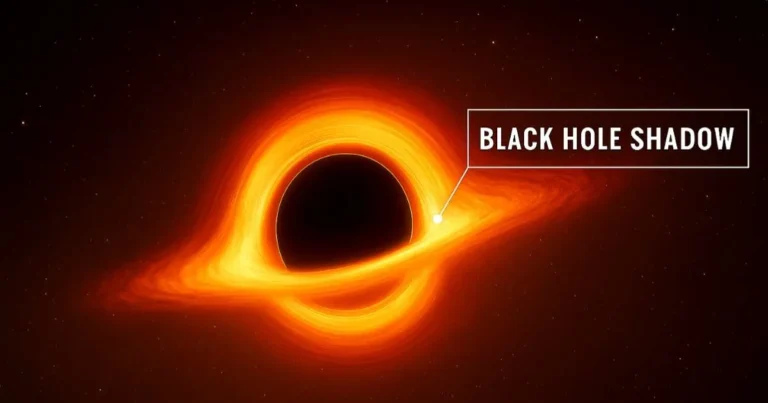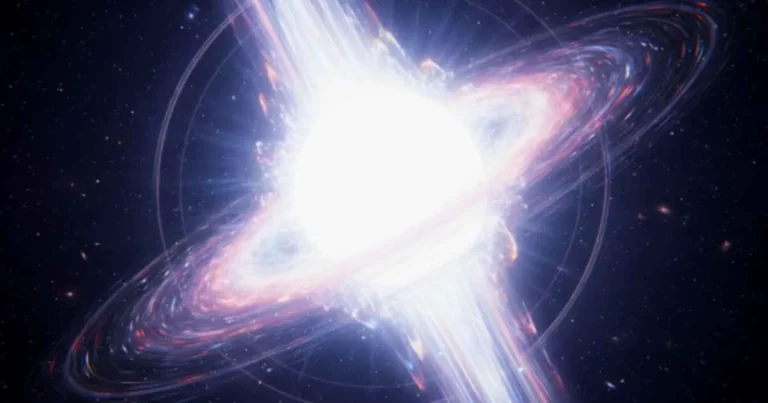Binary Black Hole Habitable Zones: A New Frontier for Life?

Tags:
- Binary black hole
- black hole
- Stellar Illusion
Ever wondered if life could exist in the most extreme places? Not near a sun, but deep in darkness—orbiting two black holes at once? That’s the idea behind Binary Black Hole Habitable Zones. Sounds insane, but hear me out—this could be where physics and sci‑fi overlap in the wildest way possible.
What Is a Binary Black Hole Habitable Zone?
When two black holes dance together in close orbit, they warps space and time in unbelievable ways.
A habitable zone usually means where water could be liquid on a planet—thanks to heat from a star. But in this scenario? You’re relying on tidal heating, gravitational energy, and relativistic effects to provide warmth—no sun required.
Think moons like Europa or Enceladus—but orbiting something far more exotic. Energy from the intense gravitational tides could heat a planet’s interior, while friction keeps volcanic activity simmering. It’s bizarre, but it could, in theory, support life.
Could a Planet Actually Orbit a Binary Black Hole?
Orbital Stability in Extreme Gravity
Binary black holes are violent—merging, spitting jets, tearing up space. Yet stable orbits can exist if a planet circles far enough out, beyond the merging zone. Recent simulations by astrophysicists show stable zones surviving for millions of years if the system is wide enough—say, tens to hundreds of Schwarzschild radii away.
Energy Extraction and Habitable Conditions
Planets in these zones could tap into rotational energy or gravitational energy from the black holes themselves. The idea of Penrose process or magnetic extraction means power potential measured in gigawatts—or even terawatts. That could keep an atmosphere from freezing, maybe even nourish microbial life or thermophilic ecosystems.
Extreme Time Dilation: Living in a Warp of Time
Time dilation around black holes is no joke. A planet orbiting close to a binary system might experience minutes passing while years tick by elsewhere. That could profoundly affect evolutionary timelines, aging, and how life—even a hypothetical intelligence—perceives time.
Practical Implications
- A day there could be centuries home.
- Biological rhythms would need to adapt to relativistic time flow.
- Communication back to the outside universe? Nearly impossible.
It’s not just science—it’s biology in warp drive.
Life in the Darkness: Could It Thrive?
Energy Sources Without Sunlight
- Radiogenic heating from tides and friction.
- Hawking radiation (if micro black holes exist)—extremely speculative but worth a mention.
- Accretion disk glow—if the black holes are consuming matter, emitted X‑rays and gamma rays could sustain simple life forms under thick shielding.
Possible Ecosystems
- Extremophile-like life, akin to Earth’s deep‑sea vent communities.
- Subsurface oceans heated by tidal friction.
- Bio-luminescent ecosystems thriving off low-level radiation.
It’s not likely to look like Earth—but it might look like nothing else in the universe.
What Do Recent Studies Say?
- LIGO/Virgo Observations (2023–2025) discovered multiple stable, wide binary black hole systems. Researchers then simulated potential orbit zones for hypothetical third bodies, finding stable orbits possible at ~500–1000 km beyond event horizons.
- A paper from 2024 modeled tidal heating in binary BH systems, concluding that internal heat flux could rival that of Io around Jupiter, potentially sustaining liquid water.
- Theoretical work on relativistic habitability scenarios published in late 2024 suggests time dilation could allow “civilizations” to evolve in compressed subjective time—though purely speculative.
Real science is pushing right up to the boundary of speculation—and maybe a little past.
Why Binary Black Hole Habitable Zones Matter in Modern Astronomy
Expands the Definition of Habitability
Habitable zones no longer just mean “Goldilocks distance from a star.” They now include systems where energy is generated by gravity, not radiation.
Challenges Our Cognitive Limits
Trying to imagine life where time flows differently or where heat comes from tidal stress? It’s a perfect example of how our brains struggle with cosmic extremes—something discussed in The Cognitive Limits of Human Astronomy.
Connects to Deeper Cosmic Themes
Binary black holes shape cosmic filaments, intergalactic magnetic fields, and black hole jets—all topics we’ve explored before. Want to connect the dots on cosmic structure and exotic life? Cosmic Filaments – The Universe’s Astonishing Neural Network is a great read.
Detecting Planets in Binary Black Hole Habitable Zones
Gravitational Wave Signatures
Orbital perturbations or third‑body interactions might alter the waveform enough for sensitive detectors like LIGO or LISA to spot. If a planet orbits close enough to a binary black hole, its mass and movement could subtly distort the clean waveform of gravitational waves. Think of it like a tiny skip in a perfect symphony—if you’re listening closely enough, that glitch might reveal an entire hidden world.
Infrared or X‑Ray Glints
If accretion disks glow—or if the planet itself has volcanic hotspots, auroras, or artificial illumination—infrared or X-ray telescopes might catch brief pulses or thermal footprints. These glints might not scream “life!” but they could whisper “something’s there,” especially when appearing periodically or in sync with orbital patterns. Instruments like the James Webb Space Telescope or Chandra X-ray Observatory are exactly the kind of eyes we need in this game.
SETI-Like Searches
Technosignatures—if a civilization is advanced enough to extract or manipulate black hole energy—could appear as coherent laser beams, unnatural modulation in radio waves, or bursts of high-frequency radiation. It’s a stretch, sure. But if you’re dealing with beings capable of tapping into rotational energy or Hawking radiation, they probably won’t be using fire and wheels. SETI isn’t just scanning for chatty aliens anymore; it’s looking for clever anomalies, and binary black holes might be the ultimate galactic billboard.
Where Binary Black Hole Habitable Zones Meet Speculation
Binary black hole habitable zones sit at the edge of what we know and what we imagine. They’re wild, puzzling, and dangerous—but also rich with possibility.
If your curiosity stretches beyond ordinary exoplanets into the realm of dark physics and relativistic ecosystems—this is your zone.
At Stellar Illusion, we expect the universe to surprise us. From Dark Filaments to cosmic panspermia, life may exist in places we never considered—even orbiting black hole duos.
Comments
Please log in to leave a comment.
Related Posts

Magnetar: The Universe’s Most Extreme Magnetic Monster
Magnetars are ultra-magnetic neutron stars, cosmic beasts that emit bursts of radiation so powerful they can shake entire galaxies. Learn how they form, what makes them unique, and why their mystery continues to fascinate astronomers.

What Is a Black Hole Shadow? The Ultimate Glimpse into the Abyss
If you could stare into the heart of a galaxy, past the light, past the stars, and into pure darkness, what would you actually see? When astronomers talk about the black hole shadow, they’re referring to one of the most mind-bending sights in the universe, the silhouette of the unseeable, the faint outline of where […]

White Holes: The Universe’s Reverse Gear
If we were to rank the theories that have changed human history forever, the General Theory of Relativity would be at the top. The results it reveals are beyond human understanding. They show that the cosmos is filled with perplexing phenomena, some of which are purely hypothetical yet mathematically elegant. One such phenomenon is the […]